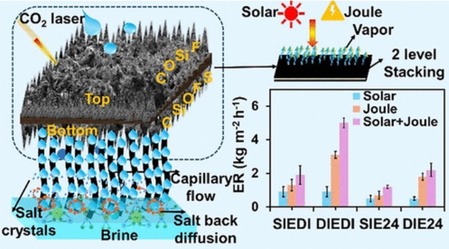IIT Bombay scientists develop lotus leaf-like solar evaporators for saltwater treatment
New Delhi, April 17: Scientists at the Indian Institute of Technology (IIT) Bombay have developed a new hydrophobic graphene-based material that could support efforts to address the freshwater crisis.
Freshwater scarcity is a significant issue in various parts of the world and is expected to intensify in the coming years. While water is abundant on Earth’s surface, only about 3 per cent of it is freshwater, and even within that, less than 0.05 per cent is easily accessible. While removing salt (desalination) from seawater and brackish water is a solution, desalination is a big problem in landlocked places.
The team led by Prof. Swatantra Pratap Singh developed the new material called the Dual-Sided Superhydrophobic Laser-Induced Graphene (DSLIG) evaporator. DSLIG evaporator can be heated via both solar heating and electricity (known as Joule heating). By combining solar and electric heating, the material is protected from fluctuations in the availability of sunlight. When there is less or no sunlight, electricity can be used to heat the evaporator and maintain similar temperatures, ensuring consistent performance. Further, DSLIG has a superhydrophobic property, meaning it repels water like lotus leaves. Owing to the characteristics of their surfaces, superhydrophobic materials reduce the contact area between water droplets and the material surface, making droplets roll over them instead of wetting. In desalination applications, the superhydrophobic nature of DSLIG helps prevent salt dissolved in water from sticking to the evaporator surface, thus maintaining efficiency over time.
“The primary goal of our work was to create a superhydrophobic surface, exhibiting the lotus effect, capable of functioning with both solar and Joule heating,” Prof. Singh said. The researchers fabricated DSLIG by coating a layer of a polymer called polyvinylidene fluoride (PVDF) on one side of a thin layer of another polymer LIG, poly(ether sulfone) (PES). Graphene was then engraved on the PVDF polymer side of the material using laser-based engraving technology. Laboratory tests show that DSLIG exhibits lotus leaf-like behaviour, and also prevents salt deposition. It showed excellent efficiency for desalination under both electric and solar heating, and in treating extremely concentrated salt solutions. DSLIG comes with a low carbon footprint, low toxicity, and cost-effectiveness making it a potential candidate for large-scale sustainable desalination applications and the treatment of industrial wastewater.



